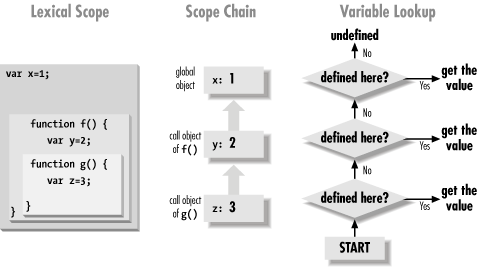
4.7. Variable Scope Revisited
When we first discussed the notion of variable scope, I based the definition solely on the lexical structure of JavaScript code: global variables have global scope and variables declared in functions have local scope. If one function definition is nested within another, variables declared within that nested function have a nested local scope. Now that we know that global variables are properties of a global object and that local variables are properties of a special call object, we can return to the notion of variable scope and reconceptualize it. This new description of scope offers a useful way to think about variables in many contexts; it provides a powerful new understanding of how JavaScript works.
Every JavaScript execution context has a scope chain associated with it. This scope chain is a list or chain of objects. When JavaScript code needs to look up the value of a variable x (a process called variable name resolution), it starts by looking at the first object in the chain. If that object has a property named x, the value of that property is used. If the first object does not have a property named x, JavaScript continues the search with the next object in the chain. If the second object does not have a property named x, the search moves on to the next object, and so on.
In top-level JavaScript code (i.e., code not contained within any function definitions), the scope chain consists of a single object, the global object. All variables are looked up in this object. If a variable does not exist, the variable value is undefined. In a (non-nested) function, however, the scope chain consists of two objects. The first is the function's call object, and the second is the global object. When the function refers to a variable, the call object (the local scope) is checked first, and the global object (the global scope) is checked second. A nested function would have three or more objects in its scope chain. Figure 4-1 illustrates the process of looking up a variable name in the scope chain of a function.

Figure 4-1. The scope chain and variable resolution

Copyright © 2003 O'Reilly & Associates. All rights reserved.



